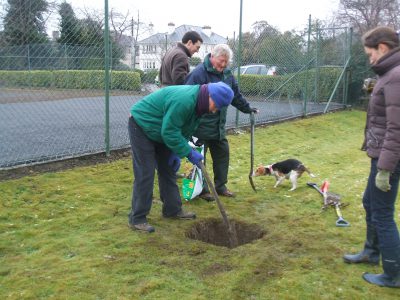 Planting edible landscapes is one of many practical ways we can prepare for a low-carbon future by increasing local resilience. It is an especially appropriate action to take this year, given that 2011 is the UN International Year of Forests.
Planting edible landscapes is one of many practical ways we can prepare for a low-carbon future by increasing local resilience. It is an especially appropriate action to take this year, given that 2011 is the UN International Year of Forests.
Churches are also asked to consider hosting Just Forests’ Wood of Life exhibition. See www.justforests.org.
Columban Faith and Justice has produced a Stations of the Rainforests DVD for Lent 2011, which incorporates the themes of extractive industries, loss of biodiversity and climate change. Links are also revealed with human impoverishment and loss of livelihoods. A resource booklet accompanies the DVD, providing the script, an agenda for meetings using the DVD, a reflection for each of the Stations and material for liturgies. £7 inclusive of p&p from Columban JPIC Office, St. Joseph’s, Watford Way, Hendon, London NW4 4TY. Tel:020 8202 2555.
The newly-formed Biblical Association of the Church of Ireland has prepared a Biblical reflective programme for Lent on the theme of Creation, which can be downloaded for free fro www.bibliahibernica.wordpress.com.
 The Diocese of Bath and Wells’ Lenten course, Love for the Future (which
The Diocese of Bath and Wells’ Lenten course, Love for the Future (whichThe Irish Catholic Bishops‘ pastoral reflection, Cry of the Earth, provides an excellent starting point for a series of discussions. It invites individuals and parish communities to reflect on the challenge of climate change and the actions we can take to help construct a more sustainable environment. Also, to reflect on the covenant between human beings and the environment “which should mirror the creative love of God, from whom we come and towards whom we are journeying”. See www.catholicbishops.ie/features.
Judy Cannato’s books, Quantum Grace: Lenten Reflections on Creation and Connectedness and Quantum Grace: The Sunday Readings (Ave Maria Press) are both excellent for individual reflection.
Also recommeded are Trócaire‘s Lent 2011 (www.trocaire.org), Christian Aid‘s Count Your Blessings (www.christianaid.ie) and Tearfund‘s Carbon Fast resources (www.tearfund.org) as well as the Ecumenical Water Network’s Seven Weeks for Water meditations and action ideas, which this year focus on the theme ‘Water, Conflict and Just Peace’ (oikoumene.org/7-weeks-for-water).
 “Over the winter months many people in Ireland experienced water shortages, which gave us a new appreciation for water and an insight into the major problems so many people in developing countries experience on a daily basis,” says ECI chairperson, Catherine Brennan SSL. “Water is a valuable resource to be preserved and shared for the benefit of all creatures and the wider creation.
“Over the winter months many people in Ireland experienced water shortages, which gave us a new appreciation for water and an insight into the major problems so many people in developing countries experience on a daily basis,” says ECI chairperson, Catherine Brennan SSL. “Water is a valuable resource to be preserved and shared for the benefit of all creatures and the wider creation.“Climate change is a reality, as can be seen from changed weather patterns throughout the globe, but by uniting together in prayer and action, we can make a real difference.”
Her Head
Near Ekuvukeni,
in Natal, South Africa,
a woman carries water on her head.
After a year of drought,
when one child in three is at risk of death,
she returns from a distant well,
carrying water on her head.
The pumpkins are gone,
the tomatoes withered,
yet the woman carries water on her head.
The cattle kraals are empty,
the goats gaunt-
no milk now for children,
but she is carrying water on her head.
The engineers have reversed the river:
those with power can keep their power,
but one woman is carrying water on her head.
In the homelands, where the dusty crowds
watch the empty roads for water trucks,
one woman trusts herself with treasure,
and carries water on her head.
The sun does not dissuade her,
not the dried earth that blows against her,
as she carries the water on her head.
In a huge and dirty pail,
with an idle handle,
resting on a narrow can,
this woman is carrying water on her head.
This woman, who girds her neck
with safety pins, this one
who carries water on her head,
trusts her own head to bring to her people
what they need now
between life and death:
She is carrying them water on her head.
© Joan Murray
